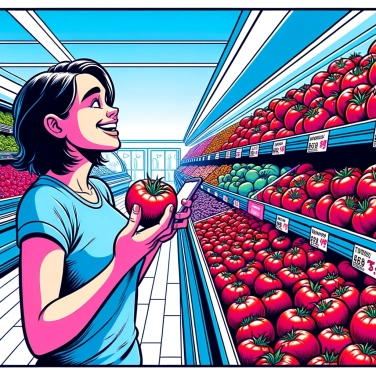Tomatoes from the supermarket often have less taste because they are harvested before ripening to withstand long-distance transportation, which affects their natural flavor development.

Tomatoes intended for supermarkets travel a lot, sometimes thousands of kilometers. They are therefore stored at low temperatures to maintain their freshness. The problem is that the cold damages their texture and halts the production of natural aromas. As a result, when they arrive on the shelves after several days spent in the cold, the tomatoes have lost a good part of their flavor, scent, and are often mealy instead of being firm and juicy.
Supermarket tomatoes are often picked long before they are ripe. Why? Because they have to endure long transportation without rotting or getting damaged. As a result, these tomatoes ripen artificially in special chambers where they are exposed to ethylene, a natural gas that they normally produce themselves when they ripen on the vine. However, by ripening this way, far from the plant, they don’t have the necessary time to develop all the sweet and balanced flavors of a fully ripe tomato. They turn red, yes, but in terms of taste, they are often bland, watery, and disappointing.
The tomatoes in supermarkets often come from varieties selected for their transport resistance, their uniform shape, or their ability to grow quickly, rather than for their taste. For a long time, producers focused on robust varieties that are easy to cultivate and well standardized. As a result, most flavorful varieties, those that offer a rich aromatic profile, have been abandoned because they are too fragile or less profitable. The result: on the shelves, we mainly find the same red tomatoes, bland and with firm flesh like cardboard.
Supermarket tomatoes often spend too much time under intense artificial lighting, disrupting their natural ripening cycle. As a result, they produce fewer sugars essential for their flavor and fail to develop interesting aromatic compounds. In short, by tanning under neon lights rather than in the sun, they become bland and tasteless. They have the perfect appearance, but the taste is no longer there, which is a shame for our taste buds.
In industrial agriculture, quantity and hardiness are often prioritized over flavor. Intensive crops use poor soils enriched with chemical fertilizers to achieve rapid large-scale production. The result: tomatoes grow quickly, but do not have the time to accumulate all the nutrients and natural flavors. The large-scale use of pesticides protects the plants but weakens their ability to develop their own natural defenses, which normally contribute to the richness of taste. By consistently prioritizing appearance, uniformity, and long-term preservation, flavor often falls by the wayside.
The tomato is technically a fruit, but it is often considered a vegetable from a culinary perspective due to its low sugar content.
Storing tomatoes in the refrigerator significantly reduces their flavor: they lose their aromatic compounds, and their natural sugars become less pronounced.
There are over 10,000 varieties of tomatoes recorded, but fewer than ten dominate the mass market and are primarily chosen for their resistance to transport, not for their taste.
The artificial ripening practiced in certain distribution channels prevents the tomato from fully developing its natural flavors, directly affecting its taste.
Among the varieties known for their flavor are the traditional Cœur de Bœuf, the Noire de Crimée, and the Sweet 100 cherry tomato. Generally, heirloom tomatoes and local varieties have a much more pronounced taste than hybrid tomatoes intended for mass distribution.
Yes, the cold changes the texture and alters the natural aroma of tomatoes. If possible, it is better to store them at room temperature, away from direct sunlight, and to consume them quickly to preserve their optimal flavor.
To slightly enhance their flavor, you can let the tomatoes ripen for a few days at room temperature before consumption, or add salt or olive oil to elevate their taste. However, this does not completely replace the flavor of a freshly picked tomato.
Not systematically, but often yes. Organic tomatoes are generally grown in richer soils, using environmentally friendly agricultural practices. They are often derived from varieties selected for their flavor rather than their durability in transport.
Garden tomatoes typically benefit from harvesting at optimal ripeness, a selection of more flavorful varieties, and cultivation in ideal natural conditions, unlike industrial tomatoes that are harvested too early and transported over long distances.

100% of respondents passed this quiz completely!
Question 1/5